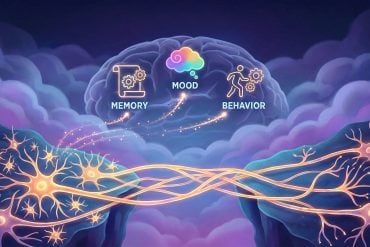Summary: Walking can enhance connections within and between three critical brain networks, one of which is linked to Alzheimer’s disease.
The research, involving older adults with normal cognitive function and those with mild cognitive impairment, showcased an improvement in memory recollection abilities after a 12-week walking exercise regimen. The brain activity observed was stronger and more synchronized post-exercise, providing hope for combating cognitive impairment and potentially delaying the onset of Alzheimer’s dementia.
The study amplifies the importance of exercise in promoting brain health.
Key Facts:
- Walking was found to strengthen connections within and between three significant brain networks (Default mode, Frontoparietal, and Salience networks), thereby potentially improving brain health.
- Participants who walked for 12 weeks showed enhanced story recall abilities, demonstrating the impact of exercise on cognitive function.
- The study highlights exercise as a potential preventive measure or stabilizing agent for people with mild cognitive impairment, possibly delaying the transition to Alzheimer’s dementia.
Source: University of Maryland
A new University of Maryland School of Public Health study reveals how walking strengthens connections within and between three of the brain’s networks, including one associated with Alzheimer’s disease, adding to the growing evidence that exercise improves brain health.
Published this month in the Journal for Alzheimer’s Disease Reports, the study examined the brains and story recollection abilities of older adults with normal brain function and those diagnosed with mild cognitive impairment, which is a slight decline in mental abilities like memory, reasoning and judgment and a risk factor for Alzheimer’s.

“Historically, the brain networks we studied in this research show deterioration over time in people with mild cognitive impairment and Alzheimer’s disease,” said J. Carson Smith, a kinesiology professor with the School of Public Health and principal investigator of the study.
“They become disconnected, and as a result, people lose their ability to think clearly and remember things. We’re demonstrating that exercise training strengthens these connections.”
The study builds upon Smith’s previous research, which showed how walking may decrease cerebral blood flow and improve brain function in older adults with mild cognitive impairment.
Thirty-three participants, who ranged between 71 and 85 years old, walked while supervised on a treadmill four days a week for 12 weeks. Before and after this exercise regimen, researchers asked participants to read a short story and then repeat it out loud with as many details as possible.
Participants also underwent functional magnetic resonance imaging (fMRI) so researchers could measure changes in communication within and between the three brain networks that control cognitive function:
- Default mode network – Activates when a person isn’t doing a specific task (think daydreaming about the grocery list) and is connected to the hippocampus – one of the first brain regions affected by Alzheimer’s disease. It’s also where Alzheimer’s and amyloid plaques, a prime suspect for Alzheimer’s disease found around nerve cells, show up in tests.
- Frontoparietal network – Regulates decisions made when a person is completing a task. It also involves memory.
- Salience network – Monitors the external world and stimuli and then decides what deserves attention. It also facilitates switching between networks to optimize performance.
After 12 weeks of exercise, researchers repeated the tests and saw significant improvements in participants’ story recall abilities.
“The brain activity was stronger and more synchronized, demonstrating exercise actually can induce the brain’s ability to change and adapt,” Smith said.
“These results provide even more hope that exercise may be useful as a way to prevent or help stabilize people with mild cognitive impairment and maybe, over the long term, delay their conversion to Alzheimer’s dementia.”
Researchers also observed stronger activity within the default mode network, within the salience network and in the connections between the three networks.
About this Alzheimer’s disease and exercise research news
Author: Kelly Blake
Source: University of Maryland
Contact: Kelly Blake – University of Maryland
Image: The image is credited to Neuroscience News
Original Research: Open access.
“Large-Scale Network Connectivity and Cognitive Function Changes After Exercise Training in Older Adults with Intact Cognition and Mild Cognitive Impairment” by J. Carson Smith et al. Journal of Alzheimer’s Disease Reports
Abstract
Large-Scale Network Connectivity and Cognitive Function Changes After Exercise Training in Older Adults with Intact Cognition and Mild Cognitive Impairment
Background:
Despite growing evidence regarding the association between exercise training (ET) and functional brain network connectivity, little is known about the effects of ET on large-scale within- and between-network functional connectivity (FC) of core brain networks.
Objective:
We investigated the effects of ET on within- and between-network functional connectivity of the default mode network (DMN), frontoparietal network (FPN), and salience network (SAL) in older adults with intact cognition (CN) and older adults diagnosed with mild cognitive impairment (MCI). The association between ET-induced changes in FC and cognitive performance was examined.
Methods:
33 older adults (78.0±7.0 years; 16 MCI and 17 CN) participated in this study. Before and after a 12-week walking ET intervention, participants underwent a graded exercise test, Controlled Oral Word Association Test (COWAT), Rey Auditory Verbal Learning Test (RAVLT), a narrative memory test (logical memory; LM), and a resting-state fMRI scan. We examined the within (W) and between (B) network connectivity of the DMN, FPN, and SAL. We used linear regression to examine associations between ET-related changes in network connectivity and cognitive function.
Results:
There were significant improvements in cardiorespiratory fitness, COWAT, RAVLT, and LM after ET across participants. Significant increases in DMNW and SALW, and DMN-FPNB, DMN-SALB, and FPN-SALB were observed after ET. Greater SALW and FPN-SALB were associated with enhanced LM immediate recall performance after ET in both groups.
Conclusion:
Increased within- and between-network connectivity following ET may subserve improvements in memory performance in older individuals with intact cognition and with MCI due to Alzheimer’s disease.






